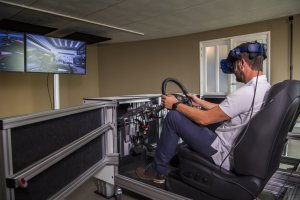Virtual Reality is probably the most exciting piece of tech in simracing at the moment. More and more simracers are trying it out, but which are the best games to do so with? Here's our list of the best racing games in VR.
Image Credit: Hyundai on Newspress
Able to literally place a simracer behind the wheel of their dream car, virtual reality is an amazing tool. In fact, alongside Direct Drive wheels, it is probably the most exciting piece of hardware in the industry right now.
New VR headsets seemingly release every day, all offering different specifications designed to entice gamers. Last year, we listed the best headsets for simracing in different price ranges. From the plucky, entry-level Oculus models to the jaw-dropping price tag of the market topping bits of kit. This guide has everything you need to know about the screens some of us strap to our faces to go racing.

Racing in VR compared to a traditional screen setup dramatically alters how one drives. Whilst many believe it to make you quicker, that is simply not the case for the majority of users. Sure, VR means you can easily spot apexes and judge distances to walls and other cars in a more effective way. But when it comes to car control, things get tough.
On a single screen, simracers get used to the visual signs of a rear end losing traction. However, you don't get the same point of view in VR meaning it's more difficult to hold a car on the limit. As a result, VR racers depend much more on force feedback to feel what the car is doing. The best VR games often have the best FFB.
You now know which headset to buy and how it will affect your driving. So it's probably about time you knew which games work the best in VR and which probably aren't worth attempting.
Here's our run down of the best racing games for VR. Click the button below to navigate to the next pages. As always feel free to add your favorite VR titles in the comments below.
Image Credit: Hyundai on Newspress
Able to literally place a simracer behind the wheel of their dream car, virtual reality is an amazing tool. In fact, alongside Direct Drive wheels, it is probably the most exciting piece of hardware in the industry right now.
New VR headsets seemingly release every day, all offering different specifications designed to entice gamers. Last year, we listed the best headsets for simracing in different price ranges. From the plucky, entry-level Oculus models to the jaw-dropping price tag of the market topping bits of kit. This guide has everything you need to know about the screens some of us strap to our faces to go racing.
Racing in VR compared to a traditional screen setup dramatically alters how one drives. Whilst many believe it to make you quicker, that is simply not the case for the majority of users. Sure, VR means you can easily spot apexes and judge distances to walls and other cars in a more effective way. But when it comes to car control, things get tough.
On a single screen, simracers get used to the visual signs of a rear end losing traction. However, you don't get the same point of view in VR meaning it's more difficult to hold a car on the limit. As a result, VR racers depend much more on force feedback to feel what the car is doing. The best VR games often have the best FFB.
You now know which headset to buy and how it will affect your driving. So it's probably about time you knew which games work the best in VR and which probably aren't worth attempting.
Here's our run down of the best racing games for VR. Click the button below to navigate to the next pages. As always feel free to add your favorite VR titles in the comments below.

